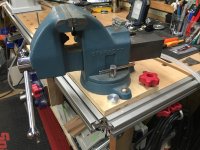ear3
Member
Since I've started to work with more slab materials, I've been thinking of investing in some pipe threading capabilities for myself, so I am not limited to putting together table bases just from off the shelf components from Home Depot or a plumbing supply place.
I'm not talking about taking it to production level, so I think I would be fine with a manual/ratchet driven threader. But it's a bit of a mystery to me all the price variation between sets.
It looks like the Ridgid 12-R set is the safest bet, but the full set is $700.
But then I see some sets for less than $60 on Amazon:https://www.amazon.com/Goplus-Ratch...eading/dp/B01AD32PPQ/ref=sr_1_6?keywords=pipe+threader&qid=1557342785&s=gateway&sr=8-6
They admittedly have a smaller selection of dies, but still, 10% the price?
I guess what I'm asking is whether there is a cheaper way to get a full pipe-threading set (or at least, capabilities of working the larger pipes between 3/4" -- 2" NPT) or if it's just safer to go with the Ridgid set right off, and not mess around with cheap alternatives.
I might also look at craigslist, as this seems like the sort of thing that would be available on that forum.
I'm not talking about taking it to production level, so I think I would be fine with a manual/ratchet driven threader. But it's a bit of a mystery to me all the price variation between sets.
It looks like the Ridgid 12-R set is the safest bet, but the full set is $700.
But then I see some sets for less than $60 on Amazon:https://www.amazon.com/Goplus-Ratch...eading/dp/B01AD32PPQ/ref=sr_1_6?keywords=pipe+threader&qid=1557342785&s=gateway&sr=8-6
They admittedly have a smaller selection of dies, but still, 10% the price?
I guess what I'm asking is whether there is a cheaper way to get a full pipe-threading set (or at least, capabilities of working the larger pipes between 3/4" -- 2" NPT) or if it's just safer to go with the Ridgid set right off, and not mess around with cheap alternatives.
I might also look at craigslist, as this seems like the sort of thing that would be available on that forum.





